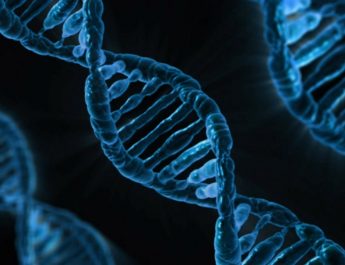In this comic, I chose to highlight physical and emotional expressions through color theory and depictions of the body. These scenes come from a sequence of events in Part Three, Chapter Eleven, where Lilith stops Peter and Gregory’s attempt to forcefully pair Allison with Gregory. The main theme I wanted to highlight from this extremely physical scene is the use of physical altercation to challenge norms of masculine social and physical dominance as well as the impact such norms can have on an individual’s identity.
For the first panel, in depicting Peter’s violent grasping of Allison’s arm, I wanted to introduce the idea of masculine superiority in terms of physical strength and command. The opening actions of this chapter describe Peter and Gregory dragging Allison to Gregory’s room with the implied intention of raping her (176). The blue forearm, representing Allison’s arm, is contrasted by the larger, red hand. I chose to keep the hands nondescript for two reasons: first, it did not matter whose hand was grabbing Allison as long as it was violent and full of malice as represented by the red aurora. Second, in addition to depicting the actual scene, the two hands show the physical dominance of men over women within this scene and in human society as well. Although not said by either of the two men, I chose to pair this panel with the quote, “What the hell is she saving herself for?” by Jean, an onlooker in support of the men’s behavior, to further highlight the male dominance inherent in this altercation. Not only are men dominating a woman physically, but the intentions and reasoning behind the domination are supported by misogynistic ideas. In both the quote and the image, Allison not only lost her agency as a woman but is also only seen as a man’s sexual partner. Stylistically, The black outlines on the white background serve to focus the attention on the colors of the arms and hands. I chose blue for Allison, representing sadness and fear, while red was chosen for the male hand representing malice and anger. I used the additional shaking effect overlayed on the hands to further indicate a sense of physical movement and panic in this situation.
While the first panel introduced the concept of social and physical male dominance, the second panel begins to depict the challenge of this norm. As the men began to drag Allison to Gregory’s room, Lilith appears to intervene. While a first attempt to command the situation falls on deaf ears, Lilith then “shouted in a voice that surprised even her (177).” Panel two depicts a close up of Lilith’s lower face and neck with an opened mouth as the centerpiece. In addition to trying to portray the action occurring in the scene, I chose to focus on Lilith’s mouth as her voice was the first active challenge to male dominance in this scene. Lilith’s mouth and voice are significant as it represents resistance from an individual usually not thought of in a position of power, a woman of color. The myriad of colors is a nod to the representation Lilith’s voice offers in terms of race in addition to depicting the range of emotions Lilith would be feeling at the time. Seeing two men drag a woman for the implied purpose of sex would trigger emotions like rage, sadness, empathy, pain, and conviction, especially in Lilith as a woman of color who also experienced sexual violence. In a broader context, the choice to only show the mouth and neck is to signal a change in the way dominance is asserted through this scene. The power has shifted from male hands to a woman’s voice. Beyond the local depiction of Lilith yelling at Peter and Gregory, we see a woman’s mouth yelling in resistance to a male-dominated society.
Panel three is a continuation of Lilith’s fight for Allison and while challenging the idea of social and physical male dominance. After yelling at the men, Lilith gets into an altercation with Gregory, Curt, and Peter in which Lilith breaks Peters arm by twisting it (178). Thanks to her conviction and the newly developed strength activated by the Oankali, Lilith is not only able to break an aggressor’s arm but, in a way, break the stereotype of male dominance in terms of physical strength. No longer can men dominate women because of a perceived strength inequality, women are now in a position to challenge the dominance of men intellectually and physically. This panel depicts Lilith’s hand wrapped around Peter’s arm, causing a compound fracture as a result of grip strength and physical force. The orientation of the hands in this panel served to contrast the first one panel as both depict the grabbing of arms by a hand but while the first panel was violent and induced a sense of panic, this panel appears more controlled in its intent and execution. Additionally, the anterior view of Peter’s arm highlights the breaking of the bone, represented by a faint outline. Like how previous panels had local and broader applications, the lack of explicit identification of the actors serves to show the challenge of male-dominant power in the scene and throughout the book as well. The use of color in this panel is a continuation of panels one and two with Peter still emitting an aura of red, albeit weaker, signifying malice and rage. Here, Lilith still possesses many colors representing a range of emotions and her identity as a woman of color. Stylistically, the change in background from white to black creates a heightened sense of contrast between the white outlines of the hands and the added color. Overall, the third panel not only continues in the stylistic patterns of the previous two but also develops Lilith’s challenge to male authority in this scene, and by extension, the book as well.
The fourth panel presents the resolution of the interaction, ending a violent altercation with a somber tone. After the fight off the men and de-escalating the situation, Allison then asks Lilith, “Are you really human?” in reference to her strength and use of force during the fight (180). Despite being saved by Lilith, a fellow woman standing up for her, Allison alludes to her belief of male dominance in physical strength. To Allison, she could not imagine a world in which a fellow human woman could physically subdue a group of men. The concept to Allison is so foreign, Lilith has to be alien. Despite her best efforts, Lilith realizes that creating a shift in perspective in terms of gender hierarchy takes more than just one fight. The alienation of Allison’s words is felt in the panel, which depicts Lilith surrounded by shadows with a very somber expression on her face. The emotions I tried to portray in her face are sadness, anger, confusion, and loneliness. The heightened emotions and sense of fighting against oppressors and an oppressive system are drained and replaced by muted colors. Within this altercation and even in the book itself, Lilith attempts to imagine a new kind of society and tries to minimize the effects of hierarchy between the people she awakened. This panel serves to close the chapter and scene with the grave realization that power dynamics cannot change as a result of a single interaction, more is needed.
As a whole, I wanted this comic to show the emotional progression that can occur as a result of challenging male dominant social norms. As much as Lilith fought against injustice and was able to save Allison, the beliefs of social and physical male dominance were so ingrained in the group and even Allison that the impact of this heroic gesture was diminished by questioning if Lilith was even a human. The use of color theory throughout the piece further demonstrates the mix of emotions inherent in such a struggle and the alienation and rejection that occurred as a result of realizing there was no change in perspective for the group or even Allison. For this comic, I wanted to expand on my artistic interpretation of the events and create a comic that was more concrete than abstract. Through the use of photoshop and many hours of tracing, I now feel more confident in my abilities to portray scenes with realism as well as incorporating abstract elements.




